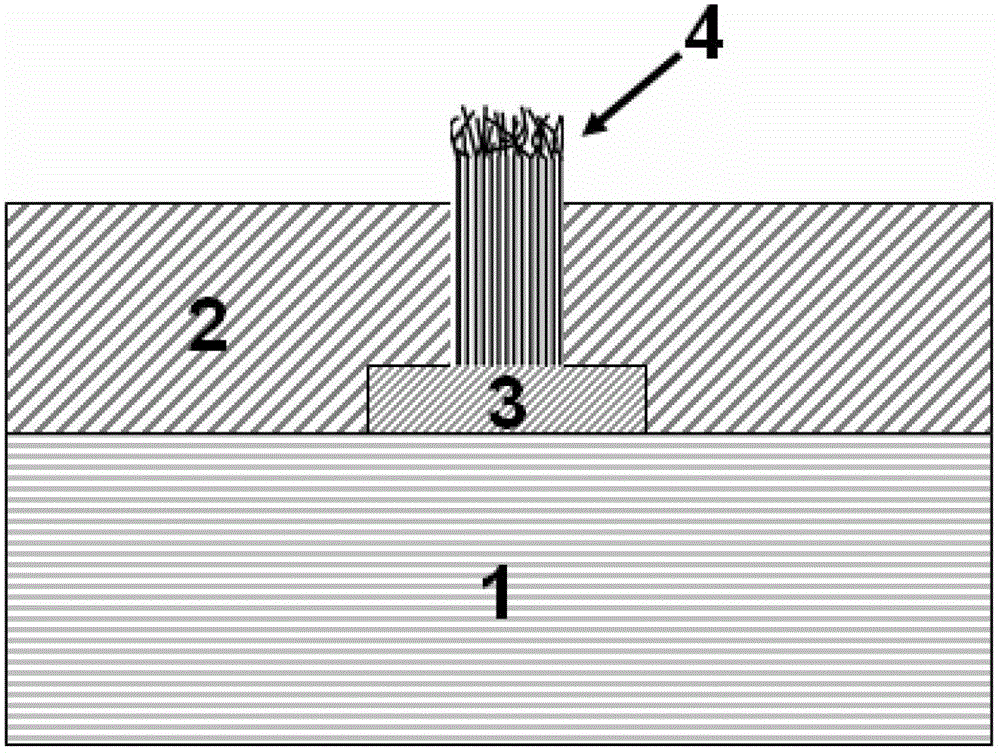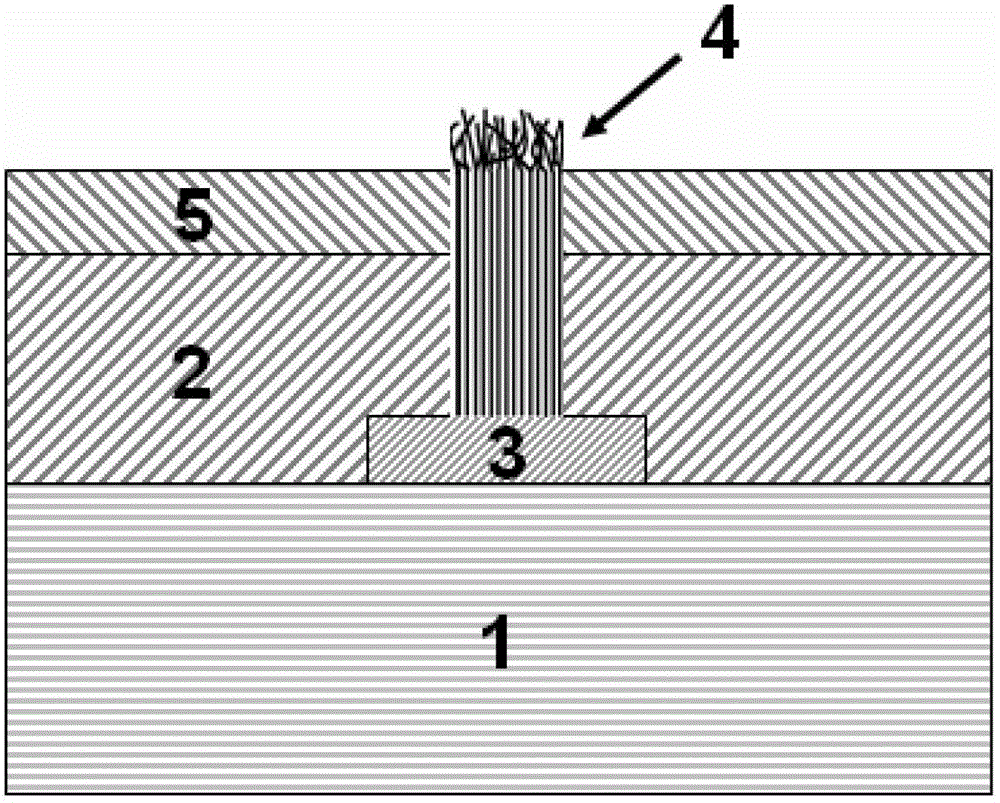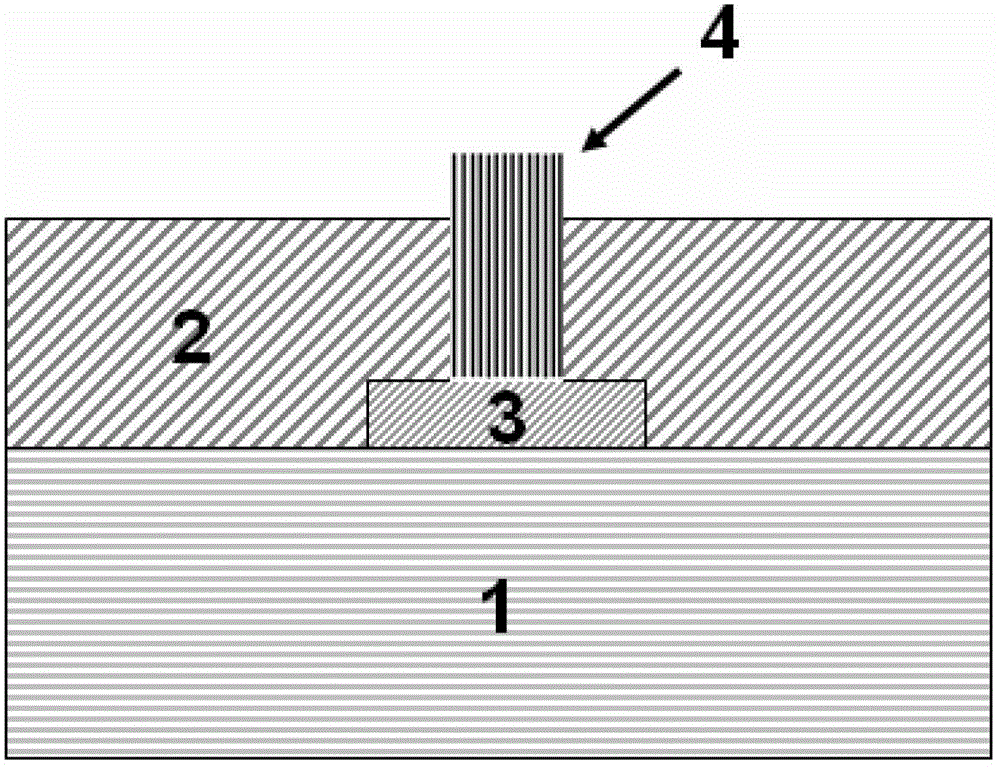Method for improving electrical interconnection characteristic of carbon nano tube
A technology of carbon nanotubes and electrical characteristics, applied in nanotechnology, nanotechnology, nanotechnology for information processing, etc., can solve the problems of low space occupancy rate of carbon nanotubes, excessive resistance, etc., and achieve improved interconnection electrical The effect of the characteristic
- Summary
- Abstract
- Description
- Claims
- Application Information
AI Technical Summary
Problems solved by technology
Method used
Image
Examples
Embodiment 1
[0043] Combined with a mask plate and a photolithography machine, a layer of high-purity aluminum 2 with a thickness of about 500 nm is sputtered on the silicon substrate 1 by magnetron sputtering as the bottom electrode. Then a silicon dioxide dielectric layer 3 with a uniform thickness is deposited on the lower electrode, and the thickness of the silicon dioxide is 3 μm. Afterwards, photolithography and BOE wet etching are used to etch a via hole above the dielectric layer corresponding to the lower electrode. The diameter of the via hole is 1 μm, and the etching stops after reaching the lower electrode.
[0044] A layer of iron with a thickness of 5 nm was deposited as a catalyst in the vias by ion beam sputtering. And use plasma-enhanced chemical vapor deposition system to grow carbon nanotubes 4 . A mixture of hydrogen and acetylene (the ratio of the two is about 1:3) is passed into the chamber, the pressure is about 900Pa, the temperature is between 500-700°C, and the g...
Embodiment 2
[0051] A bottom electrode pattern is prepared on the silicon base 1 by using a photolithography method in combination with a mask plate. Afterwards, a layer of high-purity silver 2 with a thickness of about 300 nm is deposited as the bottom electrode by electron beam evaporation. Then, a layer of silicon dioxide dielectric layer 3 with a uniform thickness was deposited on the bottom electrode by plasma enhanced chemical vapor deposition, and the thickness of the silicon dioxide was 5 μm. Afterwards, photolithography combined with dry etching is used to etch a via hole above the dielectric layer corresponding to the lower electrode. The diameter of the via hole is 2 μm, and the etching stops after reaching the lower electrode.
[0052] A layer of iron-nickel alloy with a thickness of 5nm was deposited as a catalyst in the through hole by ion beam sputtering. And use plasma-enhanced chemical vapor deposition system to grow carbon nanotubes 4 . A mixed gas of hydrogen and metha...
Embodiment 3
[0059] A bottom electrode pattern is prepared on the silicon substrate 1 by combining a mask plate and using a photolithography method. Then magnetron sputtering is used to deposit a layer of high-purity silver platinum with a thickness of about 100 nm as the bottom electrode. Then, a layer of silicon dioxide dielectric layer 3 with a uniform thickness was deposited on the lower electrode by plasma enhanced chemical vapor deposition, and the thickness of the silicon dioxide was 7 μm. Thereafter, photolithography and reactive ion etching are used to etch a via hole above the dielectric layer corresponding to the lower electrode. The diameter of the via hole is 3 μm, and the etching stops after reaching the lower electrode.
[0060]A layer of cobalt with a thickness of 5nm was deposited as a catalyst in the through holes by atomic layer deposition. And use plasma-enhanced chemical vapor deposition system to grow carbon nanotubes 4 . A mixed gas of argon, hydrogen and acetylene...
PUM
| Property | Measurement | Unit |
|---|---|---|
| thickness | aaaaa | aaaaa |
| thickness | aaaaa | aaaaa |
| thickness | aaaaa | aaaaa |
Abstract
Description
Claims
Application Information
 Login to View More
Login to View More - R&D
- Intellectual Property
- Life Sciences
- Materials
- Tech Scout
- Unparalleled Data Quality
- Higher Quality Content
- 60% Fewer Hallucinations
Browse by: Latest US Patents, China's latest patents, Technical Efficacy Thesaurus, Application Domain, Technology Topic, Popular Technical Reports.
© 2025 PatSnap. All rights reserved.Legal|Privacy policy|Modern Slavery Act Transparency Statement|Sitemap|About US| Contact US: help@patsnap.com



